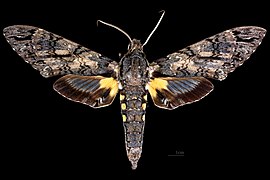Cocytius antaeus
Appearance
| Giant sphinx | |
|---|---|

| |
| Scientific classification | |
| Domain: | Eukaryota |
| Kingdom: | Animalia |
| Phylum: | Arthropoda |
| Class: | Insecta |
| Order: | Lepidoptera |
| Family: | Sphingidae |
| Genus: | Cocytius |
| Species: | C. antaeus
|
| Binomial name | |
| Cocytius antaeus | |
| Synonyms | |
| |
Cocytius antaeus, the giant sphinx, is a moth of the family Sphingidae. The species was first described by Dru Drury in 1773.
Distribution
[edit]It is found from Brazil through Central America and into the southern parts of California,[2] Texas, and Florida in the United States.
Description
[edit]The wingspan is 126–178 mm. Very rare in North America, it was once thought to be the only insect in the continent with a long enough proboscis to pollinate the ghost orchid.
-
Male dorsal
-
Male ventral
-
Female dorsal
-
Female ventral
Biology
[edit]The larvae feed on Annona glabra, Annona reticulata, Annona purpurea, Annona holosericea and Rollinia membranacea.[3]
References
[edit]- ^ "CATE Creating a Taxonomic eScience - Sphingidae". Cate-sphingidae.org. Archived from the original on 2012-08-02. Retrieved 2011-11-01.
- ^ Giant Sphinx in CA
- ^ "Silkmoths". Silkmoths.bizland.com. 2011-01-31. Archived from the original on 2016-03-04. Retrieved 2011-11-01.
External links
[edit]- Lotts, Kelly & Naberhaus, Thomas (2017). "Giant sphinx Cocytius antaeus (Drury, 1773)". Butterflies and Moths of North America. Retrieved January 1, 2019.




